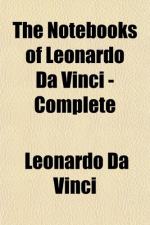The wave of the sea at Piombino is all foaming water. [Footnote 55. 56: These two lines are written below the bottom sketch on Pl. XXXV, 3. The MS. Leic. being written about the year 1510 or later, it does not seem to me to follow that the sketches must have been made at Piombino, where Leonardo was in the year 1502 and possibly returned there subsequently (see Vol. II. Topographical notes).]
Of the water which leaps up from the spot where great masses fall on its surface. Of the winds of Piombino at Piombino. Eddies of wind and rain with boughs and shrubs mixed in the air. Emptying the boats of the rain water.
[Footnote: The sketches on Pl. XXXV 3 stand by the side of lines 14 to 54.]
Of depicting natural phenomena (610. 611).
610.
The tremendous fury of the wind driven by the falling in of the hills on the caves within—by the falling of the hills which served as roofs to these caverns.
A stone flung through the air leaves on the eye which sees it the impression of its motion, and the same effect is produced by the drops of water which fall from the clouds when it [16] rains.
[17] A mountain falling on a town, will fling up dust in the form of clouds; but the colour of this dust will differ from that of the clouds. Where the rain is thickest let the colour of the dust be less conspicuous and where the dust is thickest let the rain be less conspicuous. And where the rain is mingled with the wind and with the dust the clouds created by the rain must be more transparent than those of dust [alone]. And when flames of fire are mingled with clouds of smoke and water very opaque and dark clouds will be formed [Footnote 26-28: Compare Pl. XL, 1—the drawing in Indian ink on the left hand side, which seems to be a reminiscence of his observations of an eruption (see his remarks on Mount Etna in Vol II).]. And the rest of this subject will be treated in detail in the book on painting.
[Footnote: See the sketches and text on Pl. XXXVIII, No. 1. Lines 1-16 are there given on the left hand side, 17-30 on the right. The four lines at the bottom on the right are given as No. 472. Above these texts, which are written backwards, there are in the original sixteen lines in a larger writing from left to right, but only half of this is here visible. They treat of the physical laws of motion of air and water. It does not seem to me that there is any reason for concluding that this writing from left to right is spurious. Compare with it the facsimile of the rough copy of Leonardo’s letter to Ludovico il Moro in Vol. II.]




